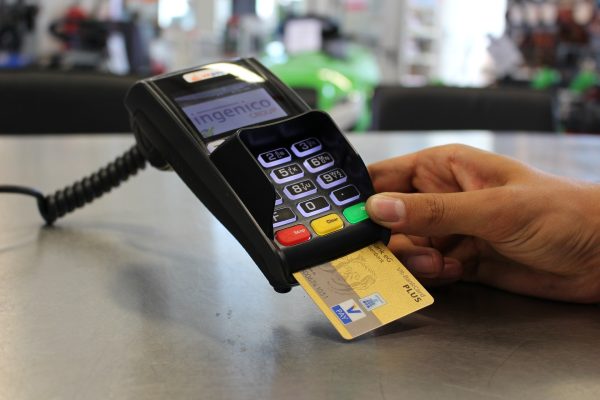

Finance
How To Reconcile Credit Card Statements
Published: November 7, 2023
Learn how to efficiently reconcile credit card statements and manage your finances with our comprehensive guide on finance.
(Many of the links in this article redirect to a specific reviewed product. Your purchase of these products through affiliate links helps to generate commission for LiveWell, at no extra cost. Learn more)
Table of Contents
- Introduction
- Step 1: Gather Your Credit Card Statements
- Step 2: Review Statement Details
- Step 3: Compare Transactions with Receipts
- Step 4: Check for Unauthorized Charges
- Step 5: Note Discrepancies or Errors
- Step 6: Contact the Credit Card Company
- Step 7: Keep Track of Outstanding Items
- Step 8: Reconcile and Balance Your Statement
- Step 9: Follow Up on Pending Items
- Conclusion
Introduction
Reconciling credit card statements is an essential task for anyone who wants to maintain control over their finances. It ensures accuracy and helps you identify any discrepancies or fraudulent charges on your card. Reconciling your statements involves comparing your credit card transactions with your receipts and noting any discrepancies or errors. By doing so, you can take appropriate action to resolve any issues and keep your financial records in order.
However, the process of reconciling credit card statements can be daunting, especially if you are not familiar with the steps involved. In this article, we will guide you through a step-by-step process that will make the task easier and more manageable.
By following these steps, you will gain a deeper understanding of your credit card transactions, ensure the accuracy of your statements, and have the peace of mind that your finances are in order. So, let’s get started on the journey of reconciling your credit card statements!
Step 1: Gather Your Credit Card Statements
The first step in reconciling your credit card statements is to gather all the relevant documents. This includes your credit card statements from each billing cycle. It’s important to have access to both digital and physical copies of your statements, as this will make the reconciliation process more efficient.
Start by logging into your online banking portal and downloading the PDF version of your statements. Save them to a dedicated folder on your computer for easy access. If you receive physical statements in the mail, make sure to collect and organize them in a designated folder or binder.
Once you have gathered all your statements, it’s a good idea to double-check that you have received statements for all your credit cards. Sometimes, statements might get lost in the mail, so it’s essential to ensure you have all the necessary documents to proceed with the reconciliation process.
If you notice that you are missing any statements, reach out to your credit card issuers and request copies. They will typically be able to provide you with duplicates or access to online versions of your statements. It’s crucial to have a complete set of statements to accurately reconcile your credit card transactions.
Additionally, if you have multiple credit cards, it’s helpful to organize them by card issuer or by the order in which they need to be reconciled. This will make it easier to navigate through the reconciliation process when we move forward with the subsequent steps.
By taking the time to gather all your credit card statements and keeping them organized, you are setting yourself up for success in reconciling your transactions and ensuring the accuracy of your financial records.
Step 2: Review Statement Details
Once you have gathered your credit card statements, the next step in reconciling them is to review the details of each statement. Carefully examine each statement to familiarize yourself with the important information it provides.
Start by verifying the statement period. This indicates the specific time frame covered by the statement, usually a month or a billing cycle. Make a note of the start and end dates of the period, as this will be useful when cross-referencing transactions with your receipts.
Next, pay attention to the statement balance. This is the outstanding amount you owe on your credit card at the end of the statement period. It includes any new charges, interest fees, and any payments or credits applied during the period. Understanding your statement balance is crucial for reconciling your transactions and ensuring accuracy.
Review the transaction section of the statement. This is where all the charges, credits, and other transactions made during the statement period are listed. Take note of the date, description, and amount of each transaction. It’s important to pay close attention to any unfamiliar or suspicious charges that may have been made on your card.
Additionally, some credit card statements include a summary of interest charges, fees, and rewards earned during the statement period. Take a moment to review these sections as well, as they provide valuable insights into the financial aspects of your credit card usage.
If you come across any unfamiliar or questionable transactions, make a note of them. It’s important to identify and address any unauthorized charges as soon as possible. These could be the result of fraud or identity theft, and taking prompt action will help protect your financial security.
By thoroughly reviewing the details of your credit card statements, you will have a clear understanding of the transactions and charges associated with your credit card. This will serve as a foundation for the next steps in reconciling your credit card statements.
Step 3: Compare Transactions with Receipts
In Step 3 of reconciling your credit card statements, you will compare the transactions listed on your credit card statement with your receipts. This process ensures that all the charges on your statement are accurate and valid.
Start by gathering your receipts for the corresponding statement period. Sort them by date and compare each receipt with the corresponding transaction listed on your statement. Look for any discrepancies in the amounts, dates, or merchant names.
As you compare your receipts with the statement transactions, make sure to take note of any discrepancies or missing receipts. This could be an indication of a duplicate charge, a transaction that didn’t go through properly, or even potential fraud.
If you discover a discrepancy between a transaction on your statement and your receipt, there are a few steps you can take. First, double-check the transaction date on your receipt to ensure it matches the statement. Sometimes, delays in processing transactions can cause variations in dates.
If you still can’t match a transaction on your statement with a receipt, try to recall the specific purchase or contact the merchant directly. They may be able to provide additional information or confirm the transaction details.
In cases where you suspect fraudulent activity or unauthorized charges, contact your credit card issuer immediately. They will guide you on the necessary steps to address the issue and protect your account.
Remember to be diligent as you compare your transactions with your receipts. Even small discrepancies can add up over time, potentially affecting your overall credit card balance and financial well-being.
By comparing your credit card statement transactions with your receipts, you are ensuring the accuracy of your charges and identifying any potential errors or fraudulent activity. This step is essential for maintaining control over your finances and protecting yourself from unauthorized charges.
Step 4: Check for Unauthorized Charges
One of the critical aspects of reconciling credit card statements is checking for any unauthorized charges. Unauthorized charges can occur due to various reasons, such as identity theft, fraud, or errors. It is important to be vigilant and address any unauthorized charges promptly to safeguard your financial security.
Review your credit card statement carefully, scrutinizing each transaction for any unfamiliar or suspicious charges. Keep an eye out for any transactions that you did not authorize or recognize. These could include purchases from unknown merchants, unusually large amounts, or transactions made in locations you have not visited.
If you identify any unauthorized charges on your statement, take immediate action. Contact your credit card issuer’s customer service department and report the unauthorized charges. They will guide you through the necessary steps to dispute the charges and protect your account.
It is a good idea to keep notes of the suspicious charges, including the date, transaction amount, and merchant information. This information will be helpful when speaking with your credit card issuer and providing evidence of unauthorized activity.
While reviewing your statement, it is also worth checking for any duplicate charges. Sometimes, due to processing errors or technical glitches, you may see the same transaction appear multiple times on your statement. If you notice any duplicates, make a note of them and contact your credit card issuer to rectify the situation.
Remember, vigilance is key when it comes to identifying unauthorized charges on your credit card statements. Promptly addressing such charges will protect your financial well-being and help maintain the integrity of your credit card account.
By thoroughly checking for unauthorized charges, you are actively safeguarding yourself against potential fraudulent activity and ensuring the accuracy of your credit card statements.
Step 5: Note Discrepancies or Errors
As you continue to reconcile your credit card statements, it’s crucial to note any discrepancies or errors you come across. These could include incorrect charges, missing credits, or any other inconsistencies you observe during the process.
When reviewing your statement, pay close attention to the amounts listed for each transaction. Check if they match the amounts on your receipts or the actual purchases you made. If you notice any discrepancies, make a note of them for further investigation.
Additionally, keep an eye out for any missing credits or refunds that should have been applied to your account. This could include returns or reimbursements that have not been properly recorded on your statement. Make sure to make a note of these discrepancies as well.
It’s also important to note any errors in merchant names or descriptions. Sometimes, a charge may appear under a generic name or an unfamiliar abbreviation. If you are having trouble identifying a specific transaction, jot down the details so you can contact the merchant for clarification.
As you go through your credit card statements, keep a meticulous record of any discrepancies or errors you encounter. This will help you take the appropriate steps to resolve them and ensure the accuracy of your financial records.
Remember, mistakes can happen, and even credit card issuers can make errors. By diligently noting any discrepancies or errors, you are taking proactive steps to rectify them and maintain control over your credit card transactions.
By noting any discrepancies or errors, you are actively working towards ensuring the accuracy of your credit card statements and protecting yourself from any potential financial discrepancies.
Step 6: Contact the Credit Card Company
Once you have identified discrepancies, errors, or unauthorized charges while reconciling your credit card statements, it’s time to reach out to your credit card company. Contacting your credit card company is crucial for addressing these issues and resolving any concerns related to your account.
Start by gathering all the necessary information related to the discrepancies or errors you’ve noted. This includes transaction dates, amounts, merchant names, and any supporting evidence such as receipts or screenshots of online purchases. Having this information readily available will make your conversation with the credit card company smoother and more effective.
Reach out to the customer service department of your credit card company using the contact information provided on the back of your credit card, statement, or their website. Explain the discrepancies or errors you have identified, providing as much detail as possible. You may need to provide account information and answer security questions to verify your identity.
If you have discovered unauthorized charges, inform the credit card company immediately. They will guide you through their fraud resolution process and take the necessary steps to protect your account from further unauthorized activity.
While speaking with the credit card company representative, keep a record of the date, time, and name of the person you spoke with. This documentation will be helpful for future reference if needed.
During your conversation, ask about the steps they will take to investigate or resolve the discrepancies or errors. They may issue a credit for the disputed amount, provide more details about a particular transaction, or guide you on how to proceed further.
Remember to remain calm and patient during your communication with the credit card company. Resolving these issues may take some time, but by staying proactive and cooperative, you increase the chances of reaching a satisfactory resolution.
By contacting your credit card company, you are taking the necessary steps to address the discrepancies, errors, or unauthorized charges on your credit card statement. Their expertise and assistance will help you resolve these issues and maintain the integrity of your account.
Step 7: Keep Track of Outstanding Items
As you continue to reconcile your credit card statements and address any discrepancies or errors, it’s important to keep track of any outstanding items that require further attention. By maintaining a record of these items, you can ensure that they are resolved and accounted for in a timely manner.
Outstanding items refer to transactions or issues that have not been fully resolved or clarified during the reconciliation process. These could include disputed charges that are under investigation, missing credits or refunds that are pending, or any other unresolved matters related to your credit card statement.
Start by making a list of the outstanding items on a separate sheet of paper or on a digital document. Include details such as the transaction date, description, amount, and the reason why it is considered an outstanding item.
For example, if you have contacted your credit card company about a disputed charge and they are still in the process of investigating, make a note of it. Similarly, if you are awaiting a credit or refund for a returned item, record that as an outstanding item until it has been resolved and reflected on your statement.
Keep this list updated as you continue your reconciliation process and follow up on any outstanding items regularly. This will help you stay organized and ensure that nothing falls through the cracks.
Some credit card issuers provide online tools or portals where you can track the status of outstanding items directly. If available, take advantage of these resources to easily monitor the progress of your disputes, credits, or other unresolved matters.
By keeping track of outstanding items, you are taking proactive steps to address and resolve any unresolved matters related to your credit card statement. This level of organization will help you stay on top of your financial records and maintain the accuracy of your credit card account.
Step 8: Reconcile and Balance Your Statement
Once you have addressed all discrepancies, errors, and outstanding items, it’s time to reconcile and balance your credit card statement. This step ensures that all your transactions have been properly accounted for and that your statement accurately reflects your financial activity.
Begin by reviewing each transaction on your statement and marking them as either reconciled or verified. If the transaction matches the corresponding receipt and you have resolved any discrepancies or errors, consider it reconciled. If there are any outstanding items or unresolved matters, make a note of them separately.
As you reconcile each transaction, check them off on your statement or in your digital document. This will help you keep track of your progress and ensure that you don’t miss any items.
Next, calculate your total spending or charges for the statement period. Add up all the transaction amounts listed on your statement, excluding any disputed or unresolved items. Compare this total with your own records or budget to ensure accuracy.
Now, subtract any credits, refunds, or adjustments that have been applied to your statement. These may include returns, reimbursements, or any other adjustments made by the credit card company to correct errors or resolve disputes.
The resulting amount should match your actual credit card balance for the statement period. If there is a discrepancy, review your calculations and verify that all reconciliations and adjustments have been properly accounted for.
If you are unable to find a resolution or there is still a discrepancy in your statement, contact your credit card company for further assistance. They can provide clarification or help investigate any remaining issues.
Once you have successfully reconciled and balanced your credit card statement, make sure to keep a copy for your records. This will serve as a reference point in the future and will be valuable for tax purposes or budgeting.
By taking the time to reconcile and balance your statement, you can be confident in the accuracy of your credit card transactions and maintain control over your financial records.
Step 9: Follow Up on Pending Items
After reconciling your credit card statement and resolving any discrepancies or errors, it’s important to follow up on any pending items that require further action or monitoring. This step ensures that all outstanding matters related to your credit card statement are properly addressed and resolved.
Review your list of outstanding items that you created during the reconciliation process. Identify any items that are still pending or have not been fully resolved. These could include disputed charges that are still under investigation, credits or refunds that are yet to be applied, or any other unresolved matters related to your credit card statement.
Contact your credit card company to get an update on the status of these pending items. Inquire about the progress of any investigations or resolutions that were initiated during the reconciliation process. Take note of the date, time, and information provided by the representative you speak with for future reference.
If any pending items appear to have been overlooked or are taking longer than expected to resolve, escalate the matter to a supervisor or manager within the credit card company’s customer service department. Be persistent in seeking resolution and advocate for your rights as a cardholder.
Keep track of any communication or correspondence related to the pending items. This includes any emails, letters, or documentation received from the credit card company regarding the ongoing investigation or resolution of the matter.
Follow up regularly until each pending item is resolved and properly reflected on your credit card statement. Document the updates provided by the credit card company and ensure that any promised actions are completed within a reasonable timeframe.
By actively following up on pending items, you are demonstrating your commitment to resolving any outstanding matters related to your credit card statement. This level of engagement will help ensure that all discrepancies, errors, or unresolved issues are fully addressed and resolved to your satisfaction.
Remember that patience and persistence are key when dealing with pending items. Your proactive approach will contribute to maintaining the accuracy of your credit card records and the integrity of your financial accounts.
Conclusion
Reconciling credit card statements is an important task that allows you to maintain control over your finances, identify discrepancies, and protect yourself from unauthorized charges. By following the step-by-step process outlined in this article, you can effectively reconcile your credit card statements and ensure the accuracy of your financial records.
Starting with gathering your credit card statements and reviewing the details, you’ll have a comprehensive understanding of your transactions. Comparing transactions with receipts helps you identify any discrepancies or errors that may have occurred. Checking for unauthorized charges and noting any discrepancies or errors is crucial for addressing potential fraudulent activity or mistakes.
Contacting your credit card company is a pivotal step in resolving any issues and seeking assistance with investigation or resolution. Keeping track of outstanding items and following up on pending matters ensures that nothing falls through the cracks and all discrepancies are addressed properly.
Finally, reconciling and balancing your credit card statement provides a clear picture of your financial activity and ensures that all transactions are accurately reflected. By following these steps diligently, you maintain control over your credit card finances and protect your financial well-being.
Remember, regular reconciliation of your credit card statements is essential for maintaining a healthy financial lifestyle. It allows you to detect and address any discrepancies, errors, or potential fraudulent activity promptly. Reconciling your credit card statements gives you peace of mind, enables better financial decision making, and helps you stay on top of your overall financial health.
So, make it a habit to reconcile your credit card statements regularly and stay proactive in managing your finances. By doing so, you’ll have a clearer understanding of your financial transactions and be empowered to maintain control over your credit card accounts.














